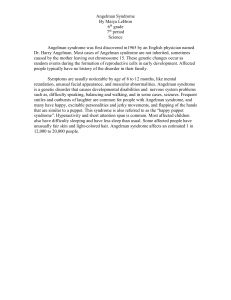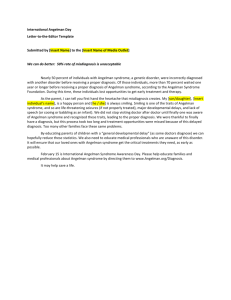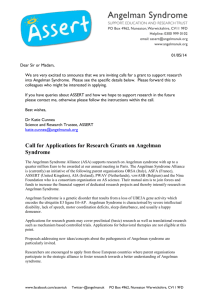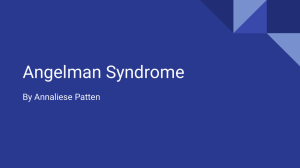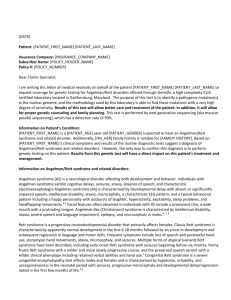Angelman Syndrome 2005: Updated Consensus for Diagnostic Criteria Conference Report
advertisement
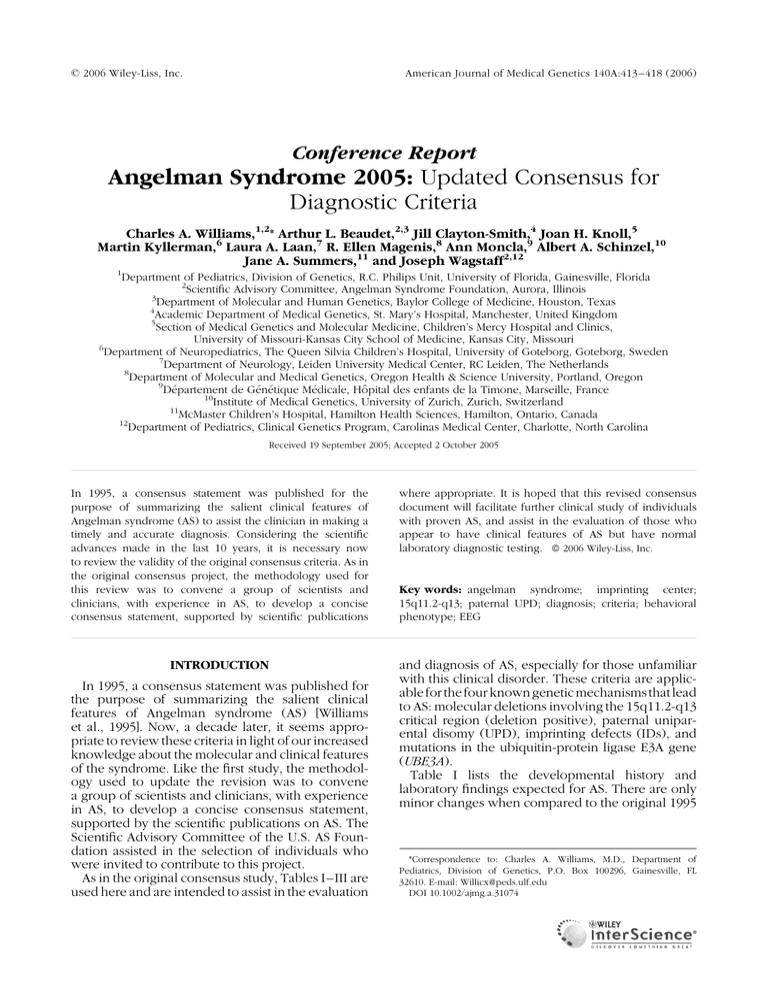
ß 2006 Wiley-Liss, Inc. American Journal of Medical Genetics 140A:413 – 418 (2006) Conference Report Angelman Syndrome 2005: Updated Consensus for Diagnostic Criteria Charles A. Williams,1,2* Arthur L. Beaudet,2,3 Jill Clayton-Smith,4 Joan H. Knoll,5 Martin Kyllerman,6 Laura A. Laan,7 R. Ellen Magenis,8 Ann Moncla,9 Albert A. Schinzel,10 Jane A. Summers,11 and Joseph Wagstaff2,12 1 Department of Pediatrics, Division of Genetics, R.C. Philips Unit, University of Florida, Gainesville, Florida 2 Scientific Advisory Committee, Angelman Syndrome Foundation, Aurora, Illinois 3 Department of Molecular and Human Genetics, Baylor College of Medicine, Houston, Texas 4 Academic Department of Medical Genetics, St. Mary’s Hospital, Manchester, United Kingdom 5 Section of Medical Genetics and Molecular Medicine, Children’s Mercy Hospital and Clinics, University of Missouri-Kansas City School of Medicine, Kansas City, Missouri 6 Department of Neuropediatrics, The Queen Silvia Children’s Hospital, University of Goteborg, Goteborg, Sweden 7 Department of Neurology, Leiden University Medical Center, RC Leiden, The Netherlands 8 Department of Molecular and Medical Genetics, Oregon Health & Science University, Portland, Oregon 9 Département de Génétique Médicale, Hôpital des enfants de la Timone, Marseille, France 10 Institute of Medical Genetics, University of Zurich, Zurich, Switzerland 11 McMaster Children’s Hospital, Hamilton Health Sciences, Hamilton, Ontario, Canada 12 Department of Pediatrics, Clinical Genetics Program, Carolinas Medical Center, Charlotte, North Carolina Received 19 September 2005; Accepted 2 October 2005 In 1995, a consensus statement was published for the purpose of summarizing the salient clinical features of Angelman syndrome (AS) to assist the clinician in making a timely and accurate diagnosis. Considering the scientific advances made in the last 10 years, it is necessary now to review the validity of the original consensus criteria. As in the original consensus project, the methodology used for this review was to convene a group of scientists and clinicians, with experience in AS, to develop a concise consensus statement, supported by scientific publications INTRODUCTION In 1995, a consensus statement was published for the purpose of summarizing the salient clinical features of Angelman syndrome (AS) [Williams et al., 1995]. Now, a decade later, it seems appropriate to review these criteria in light of our increased knowledge about the molecular and clinical features of the syndrome. Like the first study, the methodology used to update the revision was to convene a group of scientists and clinicians, with experience in AS, to develop a concise consensus statement, supported by the scientific publications on AS. The Scientific Advisory Committee of the U.S. AS Foundation assisted in the selection of individuals who were invited to contribute to this project. As in the original consensus study, Tables I–III are used here and are intended to assist in the evaluation where appropriate. It is hoped that this revised consensus document will facilitate further clinical study of individuals with proven AS, and assist in the evaluation of those who appear to have clinical features of AS but have normal laboratory diagnostic testing. ß 2006 Wiley-Liss, Inc. Key words: angelman syndrome; imprinting center; 15q11.2-q13; paternal UPD; diagnosis; criteria; behavioral phenotype; EEG and diagnosis of AS, especially for those unfamiliar with this clinical disorder. These criteria are applicable for the four known genetic mechanisms that lead to AS: molecular deletions involving the 15q11.2-q13 critical region (deletion positive), paternal uniparental disomy (UPD), imprinting defects (IDs), and mutations in the ubiquitin-protein ligase E3A gene (UBE3A). Table I lists the developmental history and laboratory findings expected for AS. There are only minor changes when compared to the original 1995 *Correspondence to: Charles A. Williams, M.D., Department of Pediatrics, Division of Genetics, P.O. Box 100296, Gainesville, FL 32610. E-mail: Willicx@peds.ulf.edu DOI 10.1002/ajmg.a.31074 American Journal of Medical Genetics: DOI 10.1002/ajmg.a 414 WILLIAMS ET AL. TABLE I. 2005: Developmental History and Laboratory Findings in AS* 1. 2. 3. 4. 5. Normal prenatal and birth history with normal head circumference and absence of major birth defects. Feeding difficulties may be present in the neonate and infant Developmental delay evident by 6–12 months of age, sometimes associated with truncal hypotonus. Unsteady limb movements and/or increased smiling may be evident Delayed but forward progression of development (no loss of skills) Normal metabolic, hematologic, and chemical laboratory profiles Structurally normal brain using MRI or CT (may have mild cortical atrophy or dysmyelination) *These findings are useful as inclusion criteria but deviations should not exclude diagnosis. table. Some comments should be noted regarding the table’s notation that the prenatal history is ‘‘normal.’’ There is an association of UPD AS with advanced maternal age presumably causing nondisjunction leading to a monosomy 15 embryo that is subsequently ‘‘rescued’’ by conversion to paternal UPD [Robinson et al., 1996, 2000]. While it does appear that fetal development and prenatal studies such as ultrasound and growth parameters remain normal in AS, it has recently been discovered that assisted reproductive technologies (ART), such as in vitro fertilization (IVF) or intra-cytoplasmic sperm injection (ICSI), are associated with a few cases of AS due to the non-deletion type of IC defect [Cox et al., 2002; Orstavik et al., 2003; Niemitz and Feinberg, 2004; Shiota and Yamada, 2005]. Another imprinting defect disorder unrelated to AS, the Beckwith– Wiedemann syndrome, has also been associated with ART. A recent report as well notes that couples who have had a prolonged time to pregnancy (i.e., beyond 2 years) may be over represented among AS individuals who have a non-deletion type of ID [Ludwig et al., 2005]. However, it is not yet known if ART confers an absolute increased risk for AS; further study is needed to determine this. Table I has also been changed to indicate that feeding problems may be present in the first 6 months of life. Questionnaire or clinical surveys among families with AS children indicate a number of feeding-related problems [Zori et al., 1992; Smith et al., 1996; Bird et al., 2005]. Many AS babies have difficulty with breast or bottle feeding including problems of apparent uncoordinated sucking, tongue thrusting, and poor breast attachment. In later infancy, gastroesophageal reflux can occur. Such feeding abnormalities can also occur in other neurological disorders so its presence is quite nonspecific regarding raising increased suspicion for the TABLE II. 2005: Clinical Features of AS A. Consistent (100%) . Developmental delay, functionally severe . Movement or balance disorder, usually ataxia of gait, and/or tremulous movement of limbs. Movement disorder can be mild. May not appear as frank ataxia but can be forward lurching, unsteadiness, clumsiness, or quick, jerky motions . Behavioral uniqueness: any combination of frequent laughter/smiling; apparent happy demeanor; easily excitable personality, often with uplifted hand-flapping, or waving movements; hypermotoric behavior . Speech impairment, none or minimal use of words; receptive and non-verbal communication skills higher than verbal ones B. Frequent (more than 80%) . Delayed, disproportionate growth in head circumference, usually resulting in microcephaly (2 SD of normal OFC) by age 2 years. Microcephaly is more pronounced in those with 15q11.2-q13 deletions . Seizures, onset usually <3 years of age. Seizure severity usually decreases with age but the seizure disorder lasts throughout adulthood . Abnormal EEG, with a characteristic pattern, as mentioned in the text. The EEG abnormalities can occur in the first 2 years of life and can precede clinical features, and are often not correlated to clinical seizure events C. Associated (20%–80%) . Flat occiput . Occipital groove . Protruding tongue . Tongue thrusting; suck/swallowing disorders . Feeding problems and/or truncal hypotonia during infancy . Prognathia . Wide mouth, wide-spaced teeth . Frequent drooling . Excessive chewing/mouthing behaviors . Strabismus . Hypopigmented skin, light hair, and eye color compared to family), seen only in deletion cases . Hyperactive lower extremity deep tendon reflexes . Uplifted, flexed arm position especially during ambulation . Wide-based gait with pronated or valgus-positioned ankles . Increased sensitivity to heat . Abnormal sleep-wake cycles and diminished need for sleep . Attraction to/fascination with water; fascination with crinkly items such as certain papers and plastics . Abnormal food related behaviors . Obesity (in the older child) . Scoliosis . Constipation American Journal of Medical Genetics: DOI 10.1002/ajmg.a ANGELMAN SYNDROME 2005: UPDATED CONSENSUS TABLE III. 2005: Genetic Test Abnormalities in AS 1. 2. 3. 4. 5. Characteristic AS pattern of DNA methylation of the SNURF-SNRPN exon 1/promoter. Detects cases due to 15q11.2-q13 deletion, UPD, and IDs (may have mosaic methylation pattern in non-deletion IDs) Abnormal FISH indicating a deletion of 15q11.2-q13 DNA sequences within the common AS deletion overlap region. Use of a pericentromeric FISH probe enhances the ability to detect subtle translocation. Array-CGH can be used to detect the deletion but confirmation by FISH is currently required. Class I and II deletions can be distinguished by array-CGH or FISH using appropriate clones DNA polymorphism analysis within 15q11.2-q13 showing paternal UPD Deletion in the Imprinting Center, demonstrated by real-time PCR, single copy FISH, or other analysis methods of the AS Imprinting Center smallest region of overlap (SRO) Pathogenic DNA sequence change in the UBE3A gene AS, Angelman syndrome; UPD, uniparental disomy; FISH, Fluorescence in situ hybridization; CGH, comparative genomic hybridization; sc, single copy; ID, imprinting defect; PCR, polymerase chain reaction. diagnosis of AS. Truncal hypotonia may also be evident during the first 6–12 months of life, and in older infants and toddlers there also appears to be an emotionally released, tension increase in the muscles, more evident in the lower than in the upper extremities. Otherwise, experience over the last 10 years has generally supported observations that early AS growth parameters are normal and that AS children lack any significant malformations or biochemical/ metabolic test abnormalities. Individual case reports have reported isolated brain malformations [Van Lierde et al., 1990; Incorpora et al., 1994; Mastroyianni and Kontopoulos, 2002; Meyer Witte et al., 2005] or other types of physical and neurological problems [Douchin et al., 2000; Harbord, 2001; Stecker and Myers, 2003; Deda et al., 2004; Katzos et al., 2004; Oiglane-Shlik et al., 2005], but these appear to be isolated reports that may be coincidental occurrences. The brain MRI description from the first consensus study appears to be still valid as indicating that there are no gross structural defects in the AS brain. Hypopigmentation is well described in 15q11.2q13 deletions (noted in Table II) due in large part to heterozygous deletion of the P gene, but true albinism can rarely occur when both P genes are affected (e.g., one gene is missing due to the 15q11q13 deletion, while the other gene has a mutation) [Fridman et al., 2003]. Of note, is a report of retinochoroidal atrophy in several older AS individuals, suggesting that visual acuity may deteriorate with aging [Rufa et al., 2003]. Better physical growth parameters have been observed in UPD and ID cases, to the extent that an overgrowth-like syndrome seems apparent [Fridman et al., 1998]. However, until more is known about these vision or growth issues, no change was deemed needed in the consensus criteria. 415 Table II lists the clinical characteristics observed in AS and conforms to a similar format used in the original consensus project in that it lists estimated percentages of clinical observations. The table is intended to be applicable to the broad group of individuals with AS, and it generally does not specify genotype–phenotype correlations to the respective AS genetic mechanisms. The clinical diagnosis is not usually suspected during the first year of life but becomes a more frequent diagnostic consideration between 1 and 4 years of age. AS can be diagnosed before the first year of life if the diagnosis is given due consideration. The four features that are observed essentially in 100% of AS cases are unchanged compared to the previous criteria study. We have however further described or qualified them. The developmental delay is still consistently in the functionally severe range, but a number of reports, using psychometric methods, now better define this severity. These studies indicate that the ceiling for psychomotor developmental achievement, on formal testing, is around the 24–30 month range [Andersen et al., 2001; Thompson and Bolton, 2003]. AS individuals have relative strengths in visual skills and social interactions that are based on non-verbal events. As expected, expressive language abilities are more impaired than receptive language abilities [Trillingsgaard and Ostergaard, 2004]. Speech impairment continues to be a consistent (100%) finding. In the original consensus statement, the degree of severity was listed as involving ‘‘no or minimal use of words.’’ It is now clear that some AS individuals with a mosaic form of an imprinting defect can have use of many words and a few of them can speak in simple sentences [Nazlican et al., 2004]. The movement and balance disorder remains as before although a caveat has been added that some may have only mild gait or movement disturbances. Behavioral uniqueness was the final category noted to have 100% consistency. The only change recommended in this category involves the removal of ‘‘short attention span’’ since one study demonstrated that poor attention ability was less common in children with AS than in non-AS controls who were matched for level of intellectual disability [Barry et al., 2005]. Regarding frequent clinical characteristics (more than 80%) the three criteria are the same as noted in 1995: delayed or disproportionate head growth, presence of seizures, and an abnormal EEG. Caveats have been added indicating that microcephaly is more prevalent with 15q11.2-q13 deletions [Moncla et al., 1999; Lossie et al., 2001]. Epileptic seizures may persist into adulthood, and the EEG abnormalities can precede clinical features and/or may not be correlated with overt clinical seizure events [Laan et al., 1996; Valente et al., 2003; Laan and Vein, 2005]. There is no difference in EEG American Journal of Medical Genetics: DOI 10.1002/ajmg.a 416 WILLIAMS ET AL. findings in AS patients with or without epileptic seizures, but the EEG findings are more pronounced in AS patients with a deletion. Characteristic EEG pattern appears in isolation or in different combinations and consists of mainly three patterns: (1) prolonged runs of rhythmic delta activity of 2–3 Hz of large amplitude, most prominent in the frontal regions and associated with superimposed epileptiform discharges, more prominent in AS children than in adults. (2) Persistent rhythmic 4–6 Hz activity of large amplitude, seen under the age of 12 years, and (3) spikes and sharp waves, mixed with 3–4 Hz components of high amplitude, mainly posteriorly and facilitated by, or only seen on, eye closure [Boyd et al., 1988; Laan and Vein, 2005]. The EEG can be helpful to support the diagnosis of AS, especially in patients without a genetic confirmation. The list of associated findings has been expanded but no feature has been deleted. Additions include traits that are often seen in the older AS child or young adult. They include abnormal food related behaviors (e.g., eating non-food items, apparent increased appetite, increased behavioral orientation to food) [Barry et al., 2005], obesity [Clayton-Smith, 1993], scoliosis [Clayton-Smith and Laan, 2003], and constipation. Attraction to or fascination with water has been expanded to include fascination with crinkly items such as certain papers and plastics. The listing of ‘‘sleep disturbance’’ has been further clarified to indicate abnormal sleep-wake cycles and diminished need for sleep; other sleep abnormalities have also been described [Bruni et al., 2004; Miano et al., 2004; Walz et al., 2005]. Individuals whose developmental history conforms to that described in Table I, and who have all of the clinical findings of groups A and B in Table II, should be considered for AS genetic testing. An abnormal methylation test (see Table III) would confirm the diagnosis, while detection of a deletion by FISH could be compatible with a diagnosis of AS or of Prader–Willi syndrome. Array-based comparative whole genomic hybridization (array-CGH) can be initially employed instead of FISH [Bejjani et al., 2005; Cheung et al., 2005]. However, a positive result should be confirmed by DNA methylation and by FISH, and/or chromosome analysis to rule out structural chromosome rearrangements. We have made changes in Table III in order to add UBE3A mutation testing and to clarify that the SNURF-SNRPN region should be used for the DNA methylation testing. Table III also notes the occurrence of methylation mosaicism for some IDs [Nazlican et al., 2004] and capability of detecting ID deletions by single copy FISH [Knoll and Rogan, 2003]. A positive AS genetic test is strong evidence for AS but a normal result does not exclude the diagnosis. In about 10%– 15% of individuals whose clinical presentation is characteristic of AS, genetic laboratory studies of chromosome 15 will be normal (e.g., no 15q11.2-q13 deletion, UPD, ID, or UBE3A abnormality). If the clinician is reasonably certain that the clinical findings in Tables I and II are present, then the diagnosis of AS could still be appropriate. This situation may change as new testing and additional insight into the molecular etiology of AS evolves. The judgment of the clinician is thus crucial when genetic testing is negative, but the clinical findings strongly suggest the syndromic diagnosis. Indeed, the importance of a correct clinical diagnosis of AS is the main reason for continued updating and dissemination of the Consensus Criteria. In general, all of the AS genetic mechanisms lead to a somewhat uniform clinical picture of severe to profound mental retardation, characteristic behaviors, and severe limitations in speech and language. However, there are some clinical differences that correlate with the genotype although there is great variability within each group [Bottani et al., 1994; Gillessen-Kaesbach et al., 1999; Moncla et al., 1999; Fridman et al., 2000; Lossie et al., 2001; Varela et al., 2004]. These correlations are broadly summarized below: 1. The deletion class is the most severely involved regarding microcephaly, seizures, relative hypopigmentation, motor difficulties (e.g., ataxia, muscular hypotonia, feeding difficulties), and language impairment. Within the deletion group there is some suggestion that those with larger deletions (e.g., BP1-BP3 breakpoints compared to those with BP2-BP3 deletions) may have more impairment in ability to speak single words [Varela et al., 2004]. 2. UPD and ID individuals have better physical growth (e.g., less likely to have microcephaly) and have less movement and ataxia abnormalities, and have a lower prevalence (but not absence) of seizures. 3. The ID and UPD groups have relatively higher developmental and language ability. The most advanced speech abilities occur in the ID group that is mosaic for the non-deletion imprint defect (about 20% of the ID group) [Nazlican et al., 2004]. These individuals may speak up to 50–60 words and use simple sentences. Other clinical disorders can mimic the features of AS, especially during infancy. These include but are not limited to Rett syndrome, 22q13.3 terminal deletion, Mowat–Wilson syndrome, alpha-thalassemia X-linked mental retardation (ATR-X) syndrome, Lennox–Gastaut syndrome, static encephalopathy with mental retardation, infantile autism, non-specific cerebral palsy, and others [Williams et al., 2001]. REFERENCES Andersen WH, Rasmussen RK, Stromme P. 2001. Levels of cognitive and linguistic development in Angelman syndrome: A study of 20 children. Logoped Phoniatr Vocol 26:2–9. Barry RJ, Leitner RP, Clarke AR, Einfeld SL. 2005. Behavioral aspects of Angelman syndrome: A case control study. Am J Med Genet Part A 132A:8–12. Bejjani BA, Saleki R, Ballif BC, Rorem EA, Sundin K, Theisen A, Kashork CD, Shaffer LG. 2005. Use of targeted array-based American Journal of Medical Genetics: DOI 10.1002/ajmg.a ANGELMAN SYNDROME 2005: UPDATED CONSENSUS CGH for the clinical diagnosis of chromosomal imbalance: Is less more? Am J Med Genet Part A 134A(3):259–267. Bird LM, Bichell TJ, Bacino CA, Beaudet AL, Sinnawi L, Kimonis V. 2005. Gastrointestinal manifestations of Angelman syndrome. Angelman Syndrome Foundation, Ninth Biennial Conference. Anaheim, CA. Bottani A, Robinson WP, DeLozier-Blanchet CD, Engel E, Morris MA, Schmitt B, Thun-Hohenstein L, Schinzel A. 1994. Angelman syndrome due to paternal uniparental disomy of chromosome 15: A milder phenotype? Am J Med Genet 51: 35–40. Boyd SG, Harden A, Patton MA. 1988. The EEG in early diagnosis of the Angelman (happy puppet) syndrome. Eur J Pediatr 147: 508–513. Bruni O, Ferri R, D’Agostino G, Miano S, Roccella M, Elia M. 2004. Sleep disturbances in Angelman syndrome: A questionnaire study. Brain Dev 26:233–240. Cheung SW, Shaw CA, Yu W, Li J, Ou Z, Patel A, Yatsenko SA, Cooper ML, Furman P, Stankiewicz P, Lupski JR, Chinault AC, Beaudet AL. 2005. Development and validation of a CGH microarray for clinical cytogenetic diagnosis. Genet Med 7: 422–432. Clayton-Smith J. 1993. Clinical research on Angelman syndrome in the United Kingdom: Observations on 82 affected individuals. Am J Med Genet 46:12–15. Clayton-Smith J, Laan L. 2003. Angelman syndrome: A review of the clinical and genetic aspects. J Med Genet 40:87–95. Cox GF, Burger J, Lip V, Mau UA, Sperling K, Wu BL, Horsthemke B. 2002. Intracytoplasmic sperm injection may increase the risk of imprinting defects. Am J Hum Genet 71:162–164. Deda G, Caksen H, Kansu A, Girgin N, Suskan E, Uysal S, Tukun A. 2004. Toxic hepatitis in a case of Angelman syndrome associated with Lennox-Gastaut syndrome. Genet Couns 15:357–361. Douchin S, Do-Ngoc D, Rossignol AM, Lucet V, Joannard A, Jouk PS. 2000. Angelman syndrome and severe vagal hypertonia. Three pediatric case reports. Arch Mal Coeur Vaiss 93:559– 563. Fridman C, Varela MC, Nicholls RD, Koiffmann CP. 1998. Unusual clinical features in an Angelman syndrome patient with uniparental disomy due to a translocation 15q15q. Clin Genet 54:303–308. Fridman C, Varela MC, Kok F, Diament A, Koiffmann CP. 2000. Paternal UPD15: Further genetic and clinical studies in four Angelman syndrome patients. Am J Med Genet 92:322–327. Fridman C, Hosomi N, Varela MC, Souza AH, Fukai K, Koiffmann CP. 2003. Angelman syndrome associated with oculocutaneous albinism due to an intragenic deletion of the P gene. Am J Med Genet Part A 119A:180–183. Gillessen-Kaesbach G, Demuth S, Thiele H, Theile U, Lich C, Horsthemke B. 1999. A previously unrecognised phenotype characterised by obesity, muscular hypotonia, and ability to speak in patients with Angelman syndrome caused by an imprinting defect. Eur J Hum Genet 7:638–644. Harbord M. 2001. Levodopa responsive Parkinsonism in adults with Angelman Syndrome. J Clin Neurosci 8:421–422. Incorpora G, Cocuzza M, Mattina T. 1994. Angelman syndrome and vermian cyst. Am J Med Genet 52:246–247. Katzos G, Triantafyllou P, Gombakis N, Sofocleous C, Zafeiriou DI. 2004. Thelarche variant in a girl with Angelman syndrome. Brain Dev 26:339–341. Knoll JH, Rogan PK. 2003. Sequence-based, in situ detection of chromosomal abnormalities at high resolution. Am J Med Genet Part A 121A:245–257. Laan LA, Vein AA. 2005. Angelman syndrome: Is there a characteristic EEG? Brain Dev 27:80–87. Laan LA, den Boer AT, Hennekam RC, Renier WO, Brouwer OF. 1996. Angelman syndrome in adulthood. Am J Med Genet 66: 356–360. Lossie AC, Whitney MM, Amidon D, Dong HJ, Chen P, Theriaque D, Hutson A, Nicholls RD, Zori RT, Williams CA, Driscoll DJ. 417 2001. Distinct phenotypes distinguish the molecular classes of Angelman syndrome. J Med Genet 38:834–845. Ludwig M, Katalinic A, Gross S, Sutcliffe A, Varon R, Horsthemke B. 2005. Increased prevalence of imprinting defects in patients with Angelman syndrome born to subfertile couples. J Med Genet 42:289–291. Mastroyianni SD, Kontopoulos E. 2002. Split-cord malformation in a girl with Angelman syndrome: A mere coincidence? Am J Med Genet 111:57–60. Meyer Witte S, Espil-Taris C, Cenraud C, Le Brun S, Loiseau H, Chateil JF, Lacombe D, Pedespan JM. 2005. Angelman syndrome and intracranial aneurysm: Fortuitous association or commune genetic predisposition? Arch Pediatr 12:431– 433. Miano S, Bruni O, Leuzzi V, Elia M, Verrillo E, Ferri R. 2004. Sleep polygraphy in Angelman syndrome. Clin Neurophysiol 115: 938–945. Moncla A, Malzac P, Livet MO, Voelckel MA, Mancini J, Delaroziere JC, Philip N, Mattei JF. 1999. Angelman syndrome resulting from UBE3A mutations in 14 patients from eight families: Clinical manifestations and genetic counselling. J Med Genet 36:554–560. Nazlican H, Zeschnigk M, Claussen U, Michel S, Boehringer S, Gillessen-Kaesbach G, Buiting K, Horsthemke B. 2004. Somatic mosaicism in patients with Angelman syndrome and an imprinting defect. Hum Mol Genet 13:2547–2555. Niemitz EL, Feinberg AP. 2004. Epigenetics and assisted reproductive technology: A call for investigation. Am J Hum Genet 74:599–609. Oiglane-Shlik E, Rein R, Tillmann V, Talvik T, Ounap K. 2005. A female with Angelman syndrome and unusual limb deformities. Pediatr Neurol 33:66–69. Orstavik KH, Eiklid K, van der Hagen CB, Spetalen S, Kierulf K, Skjeldal O, Buiting K. 2003. Another case of imprinting defect in a girl with Angelman syndrome who was conceived by intracytoplasmic semen injection. Am J Hum Genet 72:218– 219. Robinson WP, Langlois S, Schuffenhauer S, Horsthemke B, Michaelis RC, Christian S, Ledbetter DH, Schinzel A. 1996. Cytogenetic and age-dependent risk factors associated with uniparental disomy 15. Prenat Diagn 16:837–844. Robinson WP, Christian SL, Kuchinka BD, Penaherrera MS, Das S, Schuffenhauer S, Malcolm S, Schinzel AA, Hassold TJ, Ledbetter DH. 2000. Somatic segregation errors predominantly contribute to the gain or loss of a paternal chromosome leading to uniparental disomy for chromosome 15. Clin Genet 57:349–358. Rufa A, Dotti MT, Orrico A, Battisti C, Carletto F, Federico A. 2003. Retinochoroidal atrophy in two adult patients with Angelman syndrome. Am J Med Genet Part A 122A:155–158. Shiota K, Yamada S. 2005. Assisted reproductive technologies and birth defects. Congenit Anom (Kyoto) 45(2):39–43. Smith A, Wiles C, Haan E, McGill J, Wallace G, Dixon J, Selby R, Colley A, Marks R, Trent RJ. 1996. Clinical features in 27 patients with Angelman syndrome resulting from DNA deletion. J Med Genet 33:107–112. Stecker MM, Myers SM. 2003. Reserpine responsive myoclonus and hyperpyrexia in a patient with Angelman syndrome. Clin Neurol Neurosurg 105:183–187. Thompson RJ, Bolton PF. 2003. Case report: Angelman syndrome in an individual with a small SMC(15) and paternal uniparental disomy: A case report with reference to the assessment of cognitive functioning and autistic symptomatology. J Autism Dev Disord 33:171–176. Trillingsgaard A, Ostergaard JR. 2004. Autism in Angelman syndrome: An exploration of comorbidity. Autism 8:163– 174. Valente KD, Andrade JQ, Grossmann RM, Kok F, Fridman C, Koiffmann CP, Marques-Dias MJ. 2003. Angelman syndrome: Difficulties in EEG pattern recognition and possible misinterpretations. Epilepsia 44:1051–1063. American Journal of Medical Genetics: DOI 10.1002/ajmg.a 418 WILLIAMS ET AL. Van Lierde A, Atza MG, Giardino D, Viani F. 1990. Angelman’s syndrome in the first year of life. Dev Med Child Neurol 32:1011–1016. Varela MC, Kok F, Otto PA, Koiffmann CP. 2004. Phenotypic variability in Angelman syndrome: Comparison among different deletion classes and between deletion and UPD subjects. Eur J Hum Genet 12:987–992. Walz NC, Beebe D, Byars K. 2005. Sleep in individuals with Angelman syndrome: Parent perceptions of patterns and problems. Am J Ment Retard 110:243–252. Williams CA, Angelman H, Clayton-Smith J, Driscoll DJ, Hendrickson JE, Knoll JH, Magenis RE, Schinzel A, Wagstaff J, Whidden EM, Zori RT. 1995. Angelman syndrome: Consensus for diagnostic criteria. Angelman Syndrome Foundation. Am J Med Genet 56:237–238. Williams CA, Lossie A, Driscoll D. 2001. Angelman syndrome: Mimicking conditions and phenotypes. Am J Med Genet 101:59–64. Zori RT, Hendrickson J, Woolven S, Whidden EM, Gray B, Williams CA. 1992. Angelman syndrome: Clinical profile. J Child Neurol 7:270–280.
